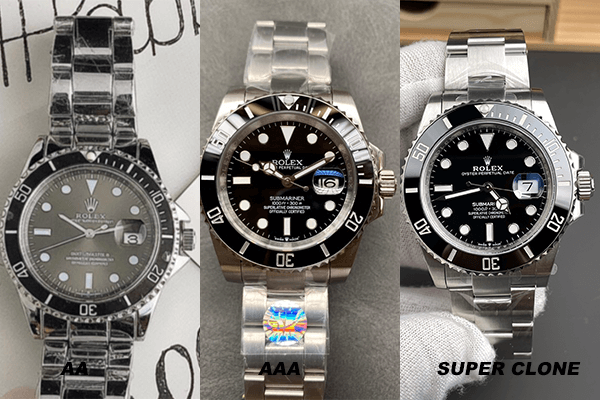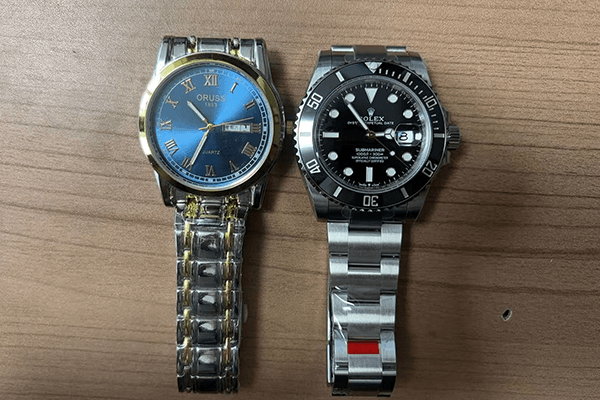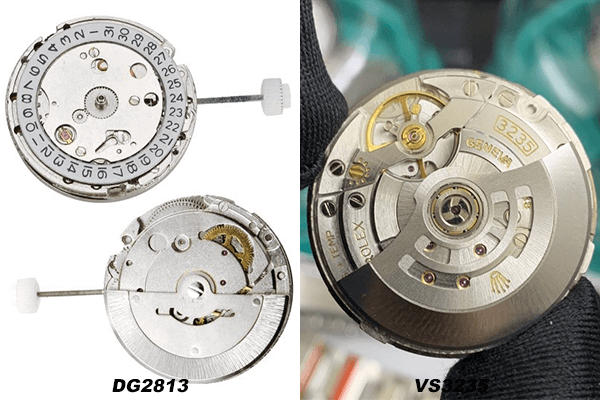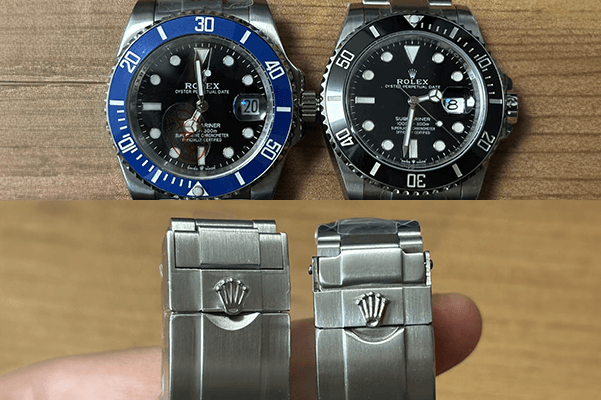Are you confused by terms like "AA," "AAA," and "Super Clone"? You're not alone. Many people worry about buying a low-quality watch that looks and feels cheap.
No, they are not created equal. High-end Super Clones1 use genuine-grade materials2, precision-cloned movements3, and 1:1 finishing4. In contrast, low-end AA/AAA watches use cheaper alloys, unreliable movements, and have many flaws you can easily see and feel. The difference is in the quality.

Now that you have the short answer, you're probably wondering what exactly makes a Super Clone worth the extra money. It's not just one thing. It's a combination of factors that separates a toy from a true timepiece. Let's dive into the three biggest factors: the materials it's made from, the movement ticking inside, and the small details that make all the difference. Understanding these will help you make a smart choice.
Does the Material Really Make a Difference in a Replica Watch?
You've probably seen watches listed with materials from "zinc alloy5" to "904L steel6." A cheap alloy feels light and tacky, and the finish can fade, instantly revealing it's a replica.
Yes, the material is critical. High-end replicas use 316L or 904L stainless steel, just like genuine luxury brands. These feel solid, resist corrosion, and hold their polish. Cheaper replicas use zinc alloy or basic steel, which are lighter, prone to fading, and feel cheap to the touch.

When I first entered the industry, I saw all levels of quality. The material is the first thing you'll notice when you hold a watch. It defines the weight, the feel, and how it will age over time. Let’s break it down into the different tiers I see every day.
Low-End Materials (AA Grade)
The lowest-end replicas often use zinc alloy for the case. You can spot this material right away. It has an unnatural, almost too-bright white shine. The biggest giveaway is the weight. It feels incredibly light, almost like plastic, and is roughly half the weight of a proper stainless steel watch. Worse, the plating on zinc alloy fades and wears off very quickly, exposing the cheap base metal underneath.
Mid-Range Materials (AAA Grade)
This is the mainstream of the replica market. These watches typically use 304L stainless steel7. Many sellers will put a fake "904L" tag on them, but it's usually 304L. This material is a big step up from zinc alloy. It has a weight and feel that is much closer to a genuine watch. It's also durable, rust-resistant, and holds a polish well. The crystal is usually mineral glass or sometimes a basic, uncoated sapphire.
Top-Tier Materials (Super Clone)
This is where replicas become almost indistinguishable from the real thing. Top factories like Clean or VS Factory use the correct materials. For a Rolex replica, that means using real 904L stainless steel, which is more resistant to corrosion and has a unique shine. For other brands, they use high-grade 316L stainless steel8. The crystals are always high-quality sapphire with anti-reflective coatings, just like the genuine versions. For watches like a high-end Richard Mille replica9, factories will even use carbon fiber and ceramic to match the genuine watch's exact look, feel, and weight.
| Grade | Primary Material | Crystal | Key Characteristics |
|---|---|---|---|
| AA | Zinc Alloy | Mineral Glass | Very light, unnatural shine, fades easily. |
| AAA | 304L Stainless Steel | Mineral/Sapphire | Good weight, rust-resistant, feels solid. |
| Super Clone | 904L/316L Steel, Ceramic, Carbon Fiber | Coated Sapphire | Identical to genuine, superior resistance, correct weight. |
What's Ticking Inside Your Replica Watch Matters, Doesn't It?
A replica might look good on the outside, but a stuttering second hand is a dead giveaway of poor quality. A cheap, unreliable movement can die suddenly, leaving you with a useless bracelet.
The movement is the heart of the watch and a huge point of difference. Super Clones use stable, reliable clone movements10 from factories like Dandong11 or Seagull12 that perfectly mimic the genuine movement's function and appearance. Cheaper watches use unstable, generic movements that are not worth repairing.

I've seen it all when it comes to movements. A great replica isn't just about looks; it's about performance and reliability. The engine inside your watch determines its accuracy, its functions, and its lifespan. The gap in quality between a low-end and high-end movement is massive.
Disposable Movements (AA/AAA Grade)
AA-grade watches almost always use a cheap Chinese quartz (battery) movement. Some may have a very basic, rough mechanical movement. AAA-grade watches often use generic automatic movements like the DG2813, Mingzhu, or MY5215. While they are automatic, they are known to be very unstable. They can lose or gain a lot of time and often break down. I call these "disposable" movements because the cost to have a watchmaker service or repair one would be more than the value of the entire watch.
High-Fidelity Clone Movements (Super Clone)
This is where top-tier replicas shine. Factories invest heavily to create "clone" movements. Factories like Dandong and Seagull are famous for this. For example, the Dandong 4130 movement is a perfect clone of the Rolex 4130 in the Daytona, with a fully working chronograph13. The DD3285 is a perfect clone for new GMT-Master II models. These movements look identical to the genuine versions, have the same functions, and are very stable and reliable. They can even be serviced by a watchmaker. Some factories, like APS, even develop completely custom movements for models like the Richard Mille to ensure total accuracy.
| Grade | Common Movements | Reliability | Serviceability |
|---|---|---|---|
| AA | Cheap Chinese Quartz/Mechanical | Very Low | Not possible |
| AAA | DG2813, MY5215, Mingzhu | Low | Not worth the cost |
| Super Clone | Dandong/Seagull Clones, Custom Integrated | High | Yes, can be serviced |
Why Do Super Clones Look So Real? It's All in the Details?
You want a replica that could pass a close inspection, not one with obvious flaws. Minor mistakes like rough edges, bad fonts, or the wrong color can ruin the entire effect.
Yes, it's absolutely about the details. Super Clones use precise CNC machining14 for cases and parts, ensuring a 1:1 match with the genuine watch. This results in sharp lines, perfect fonts, and correct colors. Cheaper watches use molds, leading to inconsistencies, burrs, and noticeable differences.

After helping thousands of clients, I can tell you that the final 1% of detail makes 99% of the difference. The finishing and manufacturing methods separate a watch that "looks like" a Rolex from a watch that "feels like" a Rolex. This is where the true craftsmanship of a Super Clone becomes clear.
Casting and Shortcuts (AA Grade)
The cheapest replicas use a simple mold to cast the case and bracelet from zinc alloy. This process is very imprecise. It results in cases that are not the right shape or size. Details are often completely wrong or missing, like the shape of the case back, the number of screws, or the design of the crown. The color of the dial or bezel will also have a serious difference from the genuine piece. These flaws are obvious even from a distance.
Basic Molding (AAA Grade)
AAA watches are better because they are made from molds using stainless steel. The overall shape is closer to the original. However, there are still major flaws. Because they use generic movements like a Miyota or DG2813, the date wheel font and position will be incorrect. You will often find "burrs," which are small, rough bits of metal on the edges of the case, hands, and bracelet. The functions might not match the real watch, for example, a chronograph dial that doesn't actually work.
Precision Machining (Super Clone)
Super Clones are made using CNC machines, the same technology used by genuine Swiss brands. A computer controls the cutting process to create a case that is a perfect 1:1 copy of the original. All edges are sharp and clean, with no burrs. The factories obsess over the details: the exact length and shape of the hands, the color and brightness of the lume, the font on the dial, and even the engravings on the movement. The functions will work exactly like the genuine watch. This precision is what you are paying for in a top-tier replica.
Conclusion
Choosing a replica is about value. AA/AAA watches are cheap but flawed, while Super Clones offer a genuine luxury experience through superior materials, movements, and meticulous 1:1 finishing.
Explore the world of Super Clones to understand their quality and craftsmanship compared to standard replicas. ↩
Learn about genuine-grade materials to appreciate the quality that goes into high-end replicas. ↩
Discover how precision-cloned movements enhance the performance of replica watches. ↩
Understand the significance of 1:1 finishing for achieving authenticity in replica watches. ↩
Learn why zinc alloy is often a red flag in the quality of replica watches. ↩
Explore the benefits of 904L steel and its role in luxury watchmaking. ↩
Discover the properties of 304L stainless steel and its use in mid-range replicas. ↩
Find out why 316L stainless steel is preferred for high-quality replica watches. ↩
Explore the intricacies of creating a high-end Richard Mille replica watch. ↩
Understand the technology behind clone movements and their importance in replicas. ↩
Explore Dandong's reputation for creating reliable clone movements in replica watches. ↩
Learn about Seagull's contributions to the quality of replica watch movements. ↩
Understand the functionality of chronographs in both genuine and replica watches. ↩
Discover how CNC machining elevates the quality of replica watches through precision. ↩
